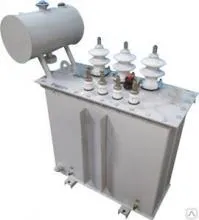Вы здесь
Трансформатор СТС-7 Т2

- МаркаМЭТЗ (Беларусь)
-
НазначениеТрансформатор понижающий многофунциональныйНазначение
Трансформатор силовой - служит для преобразования электрической энергии одного напряжения в энергию другого напряжения. Является основным оборудованием электрических подстанций.
Трансформатор для прогрева бетона и грунта - предназначен для электропрогрева и других способов электротермообработки смеси и замерзшего грунта с автоматическим регулированием температуры, в условиях строительных площадок. К данным трансформаторам присоединяется нагревательный провод ПНСВ, проложенный внутри бетона, по которому подается электрический ток, преобразующийся в температуру, доходящую до +80 градусов.
Трансформаторные подстанции - электроустановка, предназначенная для приема, преобразования (повышения или понижения) напряжения в сети переменного тока и распределения электроэнергии. Состоит из силовых трансформаторов, распределительного устройства, устройства автоматического управления и защиты, а также вспомогательных сооружений.
Трансформаторы тока - предназначен для регулировки тока
Трансформаторы напряжения - предназначен для регулировки напряжения
Трансформатор понижающий - многоцелевые трансформаторы небольших габаритов
Трансформатор разделительный - первичная обмотка отделена от вторичных обмоток при помощи защитного электрического разделения цепей: двойной или усиленной изоляции, или основной изоляции и защитного экрана. Применение такого подключения электроприемника существенно снижает вероятность поражения электрическим токомТороидальный трансформатор представляет собой высокоэффективный трансформатор, который легче и меньше, чем альтернативные трансформаторы такой же мощности. Применение тороидальных трансформаторов позволяет уменьшить массу и габариты изделий, повысить КПД, увеличить плотность монтажа
- СерияСТ, СОБС, СОС, СТС, ОСС
-
Номинальная мощность0.0231 кВАНоминальная мощностьНоминальная мощность трансформатора представляет собой значение полной мощности трансформатора на основном ответвлении, гарантированное заводом-изготовителем в номинальных условиях охлаждающей среды при номинальном напряжении и номинальной частоте.
- все характеристики найти аналог
- все товары МЭТЗ (Беларусь)
ВСЕ ХАРАКТЕРИСТИКИ ТОВАРА Трансформатор СТС-7 Т2
| Характеристика | Значение |
| Марка | МЭТЗ (Беларусь) |
|
Назначение
Трансформатор силовой - служит для преобразования электрической энергии одного напряжения в энергию другого напряжения. Является основным оборудованием электрических подстанций. Тороидальный трансформатор представляет собой высокоэффективный трансформатор, который легче и меньше, чем альтернативные трансформаторы такой же мощности. Применение тороидальных трансформаторов позволяет уменьшить массу и габариты изделий, повысить КПД, увеличить плотность монтажа |
Трансформатор понижающий многофунциональный |
| Серия | СТ, СОБС, СОС, СТС, ОСС |
|
Номинальная мощность
Номинальная мощность трансформатора представляет собой значение полной мощности трансформатора на основном ответвлении, гарантированное заводом-изготовителем в номинальных условиях охлаждающей среды при номинальном напряжении и номинальной частоте.
|
0.0231 кВА |
|
Номинальное высшее напряжение
Номинальное напряжение первичной обмотки при холостом ходе трансформатора |
200 В |
|
Номинальное низшее напряжение
Номинальное напряжение вторичной обмотки при холостом ходе трансформатора |
24 В |
|
Количество фаз
В обычных сетях применяются однофазные трансформаторы, в сетях на три провода (фаза, ноль, заземление) нужен трехфазный трансформатор.
|
Однофазный |
|
Тип диэлектрика трансформатора
По типу охлаждения устройства делятся на две категории – силовые сухие трансформаторы (с воздушным охлаждением) и силовые масляные трансформаторы
|
Сухой |
| Характеристика | Значение |
| Частота | 50 Гц |
|
Степень защиты
Маркировка степени защиты оболочки электрооборудования осуществляется при помощи международного знака защиты (IP) и двух цифр, первая из которых означает защиту от попадания твёрдых предметов, вторая — от проникновения воды. IP00 - защита отсутствует. IP65 - пыленепроницаемое, с защитой от водяных струй с любого направления
|
IP20 |
|
Масса полная
Для трансформатора - полная масса трансформатора, с учетом массы масла. Для КТП - полная масса КТП, без учета массы трансформаторов
|
0.95 кг |
|
Климатическое исполнение и категория размещения
Климатическое исполнение — как правило, указывается в последней группе знаков обозначений технических устройств. Буквенная часть обозначает климатическую зону. Следующая за буквенной цифровая часть означает категорию размещения.
|
Т2 |
| Габариты, длина | 91 мм |
| Габариты, ширина | 76 мм |
| Габариты, высота | 92 мм |
| Гарантия | 36 мес. |
Трансформаторы СТС (сигнальные трансформаторы светодиодных светофоров) предназначены для электропитания светодиодных светофоров микропроцессорных систем железнодорожной автоматики.
Трансформаторы соответствует требованиям СТБ МЭК 61558-2-6 ГОСТ 15963-79.
Вид климатического исполнения – Т2 по ГОСТ 15150-69.
Температура окружающего воздуха от минус 40 С до плюс 70 С.
Номинальные рабочие значения механических внешних воздействующих факторов – ГОСТ 30631-99 для групп механического исполнения М6 при установке в любом рабочем положении.
Трансформаторы предназначены для работы в продолжительном режиме.
Исполнение трансформаторов по условиям установки на месте работы – встраиваемые, стационарные.
В соответствии с требованиями электромагнитной совместимости
трансформаторы могут применяться в окружающей обстановке 1 – среде, характерной для оборудования, устанавливаемого в жилых, коммерческих зданиях или зданиях лёгкой промышленности, предназначенного для непосредственного подключения к низковольтным электрическим сетям общего пользования.
Класс нагревостойкости изоляции – В по ГОСТ 8865-83.
По способу защиты от поражения электрическим током трансформаторы относятся к классу II по ГОСТ 12.2.007.0-75 и имеют степень защиты IP20 по ГОСТ 14254-96.
Корректированный уровень звуковой мощности трансформаторов не должен превышать 20 дБА как при холостом ходе, так и при номинальной нагрузке.





